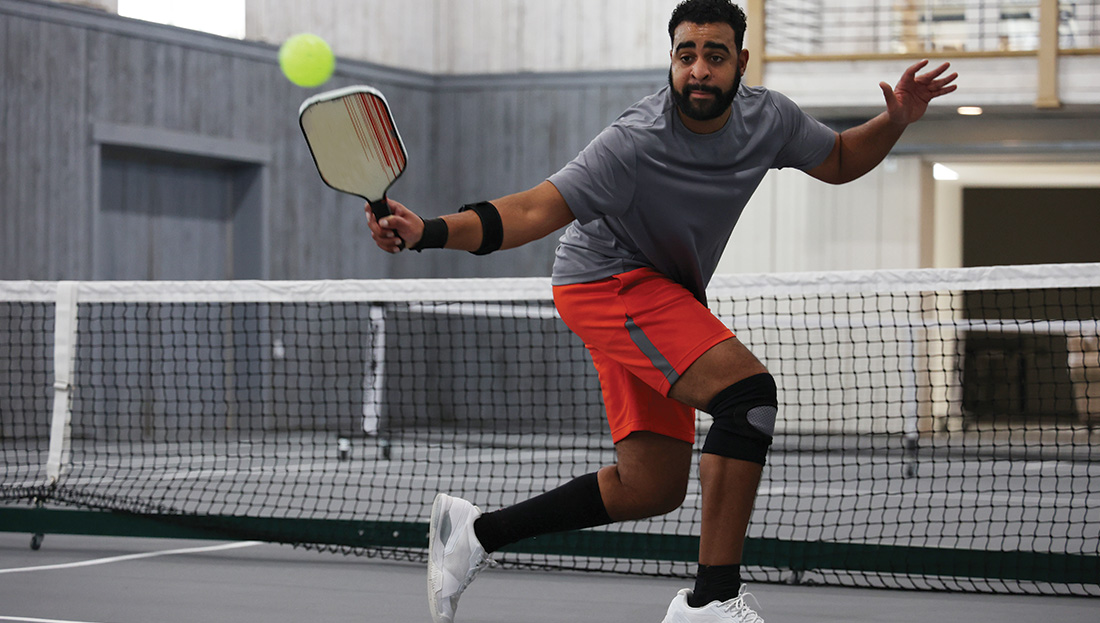
Pickleball Workout | Improve Your Game

When ACE commissioned a research study to examine the benefits of pickleball back in 2017, few people (including some of our editorial staff) had ever heard of the sport. Flashforward a few years and pickleball—a hybrid of badminton, tennis and table tennis—is now the fastest growing sport in America, according to the Sports and Fitness Industry Association. Today, the research we commissioned, which explored whether pickleball can help middle-aged and older adults get fit and was published the following year, is more relevant than ever. USA Pickleball now reports that while most of pickleball’s most dedicated players are over the age of 65, the game is getting younger, with the strongest growth among players younger than 55.
Cedric X. Bryant, PhD, FACSM, is something of a trailblazer when it comes to pickleball, having played it now for more than 20 years. Not only does it serve as a great competitive outlet for him, it’s also a bit easier on the joints than some other sports. “Personally,” says Bryant, who is ACE’s President and Chief Science Officer, “I enjoy it because it’s a reasonably joint-friendly option for playing a competitive racquet sport, which my surgically reconstructed knee appreciates.”
Of course, given that he’s dedicated his life to promoting the benefits of physical activity and getting people moving, Bryant also appreciates the accessibility of the sport. “Pickleball is an easy-to-learn racquet sport that can accommodate a wide range of participants in terms of both age and skill level, which makes it a terrific activity for getting more people moving more often.” Plus, it’s a lot of fun and, as more people discover the sport, an increasingly social activity.
So what did the ACE-supported research conclude? The average caloric expenditure for study participants, which included 40- to 85-year-old men and women, was approximately 350 calories burned for every 60 minutes of participation. This means that regular participation in pickleball elicits cardiovascular and metabolic responses that meet exercise intensity guidelines for improving and maintaining cardiorespiratory fitness. These findings support pickleball as an ideal form of physical activity for middle-aged and older adults.
This is good news for those who are looking for an activity that is both fun and social. As a health and exercise professional, you know that enjoyment is a key factor when it comes to adherence, so helping your clients find activities that are fun and provide a social element (something we recognize as even more important since the onset of the pandemic) is essential. Introducing your clients to activities they may not have considered before, such as pickleball, could open up new opportunities to be active outside your sessions or classes.
As with any sport, however, pickleball can present some challenges, particularly for those who may have balance or agility issues or are trying it for the first time. One of the concerns about the rapid growth of a sport that sees its greatest popularity among people aged 55 and older is the risk for falls and injury. In fact, the authors of the ACE-sponsored study highlighted the need for safety, pointing out that nearly every participant had fallen at least once or twice during the study.
Safe participation requires the agility and balance to perform such movements as backpedaling and returning a ball hit over the player’s head. Proper technique—for example, turning and running for the ball rather than backpedaling—coupled with an exercise regimen that prepares the body for the sport, will allow for safe participation in this fun and exciting game.
The exercise program below was designed to prepare the body for the demands of Pickleball. This workout, which can be completed two to three days per week (on nonconsecutive days), features a variety of multijoint movements across all three planes of motion to support postural stability and joint mobility and proper movement patterns.
The warm-up can be used prior to playing pickleball, in addition to being a warm-up for the conditioning segment of the workout below. For the conditioning segment, perform one set of each exercise listed and then start back at the top of the list and perform the second set of each exercise. At first, performing only one set of each exercise may be most appropriate, depending on the client’s fitness level and familiarity with the movements. Rest for 30 seconds or less between exercises.
Warm-up |
|||
|
Exercise |
Intensity |
Sets |
Repetitions |
|
|
Low-to-moderate intensity |
1 |
8–15 repetitions on each leg |
|
|
Low-to-moderate intensity |
1 |
8–15 repetitions on each leg |
|
|
Low-to-moderate intensity |
1 |
8–15 in each direction |
|
|
Low-to-moderate intensity |
1 |
As many repetitions as possible in 30 seconds |
Conditioning Segment |
|||
|
Exercise |
Intensity |
Sets |
Repetitions |
|
|
20–70% 1-RM |
1–4 |
8–15 on each leg |
|
|
20–70% 1-RM |
1–4 |
8–15 |
|
|
20–70% 1-RM |
1–4 |
8–15 rotating in each direction |
|
|
20–70% 1-RM |
1–4 |
8–15 on each side |
|
|
20–70% 1-RM |
1–4 |
8–15 on each leg |
|
|
20–70% 1-RM |
1–4 |
8–15 to each side |
|
|
20–70% 1-RM |
1–4 |
8–15 to each side |
Cool-down |
|||
|
Exercise |
Intensity |
Sets |
Repetitions |
|
Standing triangle straddle bends
|
Stretch to the point of feeling tightness or slight discomfort.
Hold stretch for 30–60 seconds. |
1 |
1–2 for a total of 60 seconds of stretching time |
|
|
Stretch to the point of feeling tightness or slight discomfort.
Hold stretch for 30–60 seconds |
1 |
1–2 for a total of 60 seconds of stretching time |
|
|
Low-to-moderate intensity |
1 |
8–15 |
|
Shoulder stability-mobility series
|
Low-to-moderate intensity |
1 |
8–15 of each formation |
|
Spinal twist with a push-pull movement
|
Low-to-moderate intensity |
1 |
8–15 on each side |
Note: 1-RM = One-repetition maximum

 by
by 

